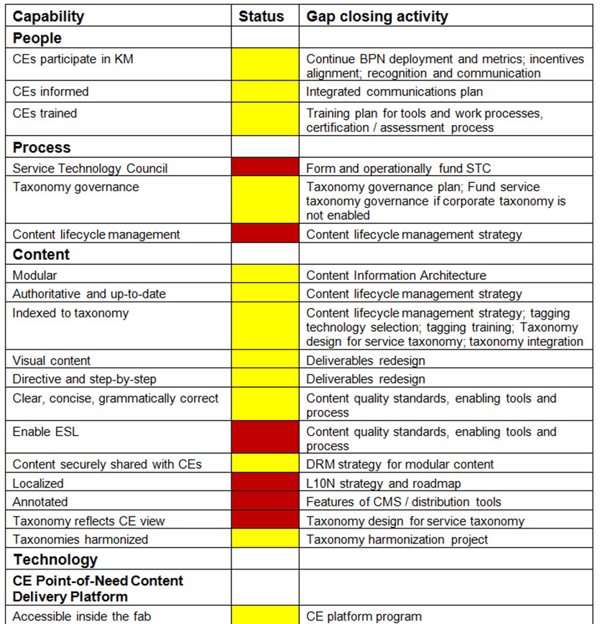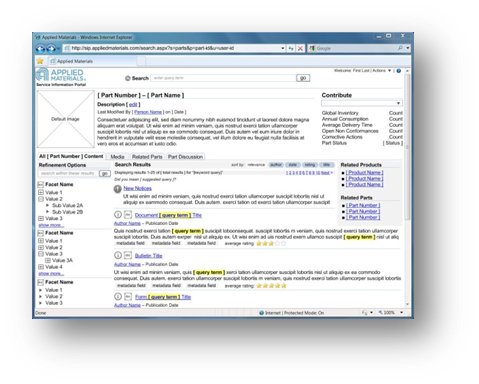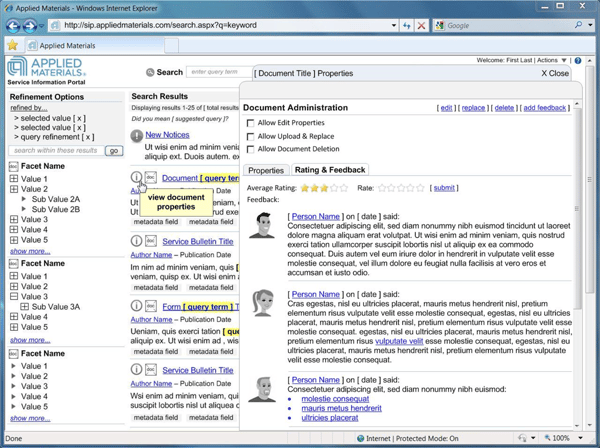Applied Materials Improves Knowledge Sharing and Reuse
Challenge
Field service technicians who support Applied Materials’ customers were spending up to 40% of their time searching for the information they needed. Findability was limited because the information was siloed and was in many different formats. Of particular importance was the need to protect each customer’s intellectual property, since many of them were competitors. AGS took responsibility for organizing the information and presenting it in a single portal but needed assistance in developing an information architecture, including enterprise taxonomies and an ontology.

Solution
In order to obtain the specialized expertise needed to support this task, Applied Materials hired Earley Information Science (EIS) to develop a strategy and a road map for the process, and to help implement the plan. EIS developed a two-phase process. During the first phase, more than 600 field service engineers were surveyed. The field engineers reported spending 9-16 hours per week looking for the information they needed. Not surprisingly, the great majority were dissatisfied with the time required. Knowledge workers spent 4.6 hours per week searching for information and did not always find what they needed.
Based on the survey data, Applied Materials could anticipate saving over half a million hours a year by having a more efficient information retrieval capability—time that could be redirected toward service tasks instead of in searching for information. In addition, customer downtime would be reduced because of more rapid servicing of equipment. EIS developed a multi-year road map to develop a virtual repository and portal, which led to the next phase of the project.
In the second phase, EIS developed an information architecture to address the need for structure and consistency across the different repositories, creating a single virtual and easily searchable repository. In this part of the project, a taxonomy and metadata framework was designed and implemented, a publishing strategy was developed, and an information governance method for auto-categorizing content was established. The governance program also ensured the protection of intellectual property of both Applied Materials and its customers. Over 30 taxonomies were developed to reflect the information contained in Applied Materials’ repositories. These included categories related to the company’s products, documents, geographical regions and technologies.
In order to fully realize the potential of the taxonomies, an ontology was developed. While a taxonomy organizes information within a domain, an ontology is a conceptual framework that enriches the use of the information by specifying connections among different information elements. At the most basic level, it defines vocabularies such as equivalencies among terminologies. In addition it encompasses the hierarchies in the taxonomies. Finally, it defines relationships among elements in the taxonomies. EIS assisted Applied Materials in defining the elements of the ontology.
Considerable work was required to implement the ontology in multiple systems and processes; incorporate it into workflows for content publication and approval; connect it to enterprise resource planning and digital asset management systems for visual part identification; and incorporate dozens of content libraries by ingesting them, automatically classifying content, and manually mapping relationships. But once this work was complete, the architecture of the Applied Materials solution allowed field technicians to get the information they needed when they needed it. It helped them locate exactly what would be most useful by building logical groupings of content—surfacing the troubleshooting guides according to the process the tech would be troubleshooting, for example. The ontology enabled this by creating hierarchies—lists of concepts that are grouped logically—so that technicians could scan groupings and infer what they needed just by scanning the list.
These hierarchies also allowed ambiguous queries to be clarified by asking questions about the parts and their applications. When they searched, the search results were grouped in a way that made sense to the technician—that fit their “mental model” of the problem and solution. These changes enabled the computer to give the technicians what they were seeking using the terms they were likely to be thinking about, rather than forcing them to root through masses of information with terms they might not recognize, organized in incompatible ways more accessible to computers than to humans.

Results
The result was a unified information access application system that reduced the time that field technicians spent searching for information by half. The technicians responded favorably to the new system. In addition, the accuracy of search results was improved. Technicians were able to reduce their component and replacement part inventories and speed turnaround time for down fabrication plants. The rules-based classification protected IP for both Applied Materials and its customers. And Applied Materials estimated their savings at tens of millions of dollars per year.

Discover Expert Insights
See the latest news in the information architecture space through our blog posts, whitepapers, webinars, and more.
